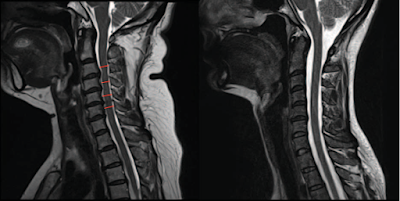As this is the first article in the series, we'll start with an introduction. I am a licensed and board certified radiologist with subspecialization in neuroradiology including spinal interventional procedures. Even though my work is primarily in the central nervous system, my training and day-to-day practice involves all general medical conditions including most if not all traumatic injuries elsewhere in the body. But more important than my credentials, I love wrestling. I have watched WWF/WWE since childhood, taking a break during the Ruthless Aggression era. I currently watch NXT, AEW, and WWE pay-per-views religiously. I watch all NJPW events and dabble in ROH and NWA.
Last thing before we start, some caveats which hereafter be put at the end of each article. These articles will be general discussions about medical topics/diagnoses. As we are not personally interacting with wrestlers and do not have intimate knowledge of their maladies, we cannot comment specifically on their medical courses unless information has been previously freely reported. These articles will reference wrestlers as examples based on what is either reported by them or their companies, but what is said beyond that will only be speculation based on the general course of a given diagnosis. I intend to write these articles so that a non-medical layperson can understand them and will attempt to use more general, colloquial terms whenever possible (i.e. "bone spur" instead of the more correct term "osteophyte" in this article). Lastly, any information here should not be used for self-diagnosis. If you are experiencing medical issues yourself, I advise you to see a licensed physician for a full evaluation. With that out of the way, on to spinal stenosis!
BACKGROUND
Many wrestlers in the WWE and elsewhere have reported being diagnosed with spinal stenosis. Some of these wrestlers have actually retired, citing spinal stenosis as a major reason. Others remain active but take prolonged periods off reportedly due to their stenosis and adjust their in-ring styles. While spinal stenosis is a common condition in the general population, it usually afflicts older and more debilitated persons. Professional wrestlers are an obvious exception to this, and their profession uniquely positions them to have spinal stenosis that is both more severe and occurs at an earlier age.
WHAT IS SPINAL STENOSIS?
Stenosis means narrowing of a pre-existing space. The spinal column is composed of bony vertebral bodies in the front which are separated by intervertebral discs and bony joints in the back. These bony elements create and surround the spinal canal in the center. Within the spinal canal we have our spinal cord surrounded by cerebrospinal fluid (CSF). The spinal cord is the structure that connects all of the neural tissue of the brain to the majority of the rest of our body, sending out nerves that tell our muscles to move and provide input to our organs. It also accumulates sensory nerves that give information back to our brain about what our body is experiencing externally and internally. This includes skin sensation of our arms and legs.
HOW DO YOU GET SPINAL STENOSIS?
The human spine is not perfectly designed to deal with upright walking and gravity. As we age, our intervertebral discs which separate our vertebral bodies in the front and the spinal column joints in the back will degenerate. This leads to soft tissue and bone spurs encroaching on the spinal canal which can then be narrowed. Alternatively, a person can have a traumatic injury of their spinal column leading to fracture fragments narrowing the canal and/or instability of the spinal column. In addition to this, there is a component of luck. We all have varying sizes of our spinal canal and some people have congenitally more narrow canals than others. People with more narrow canals may develop spinal stenosis from relatively minor degenerative or traumatic changes. People with wider canals could have extensive bone spurs and the like with minimal, if any symptoms.
HOW DOES THIS RELATE TO WRESTLING?
As above, professional wrestlers are going to be more likely to develop cervical spinal stenosis at an earlier age. Many of the bumps wrestlers take are either directly onto or involve the neck (cervical spine). This can lead to age-advanced degenerative changes or – more dramatically – fractures and dislocations. Ideally a bump on the neck is performed such that a wrestler can roll with the momentum onto the remainder of the back, dissipating the force such that the impact doesn't totally hammer their cervical spine. If a bump is taken poorly or a maneuver doesn't allow the wrestler to roll with the momentum, the wrestler is at high risk for cervical spine trauma. It is for this reason why certain maneuvers are either outlawed or tightly regulated by the WWE. Piledrivers and related techniques produce a direct loading impact on the cervical spine with no rolling component. Other techniques may land a wrestler on their neck such that it bends sharply with chin to chest and no rolling onto their back. This is why – for example – the Death Valley Driver/Attitude Adjustment is permitted but the Burning Hammer is rarely allowed. Both techniques are nearly identical with the exception of which direction the wrestler is facing when s/he lands. Similarly, a Frankensteiner/head-scissors takedown can be pretty much freely used while a reverse Frankensteiner/poison rana is more regulated.
 |
| The Velveteen Dream's maneuver - the Dream Valley Driver - lands the opponent on his neck but allows him to roll onto his back. This disperses the momentum. Image courtesy of wrestlinginc.com. |
EXAMPLES
There are too many examples to count, but a few notable wrestlers have reported being diagnosed with spinal stenosis. Two of them are especially pertinent in the current climate.
Edge famously retired in 2011 citing cervical spinal stenosis as the reason. He had prior cervical spine fusion in 2003, a general term for a surgery where a portion of the spine is locked into a fixed position using a combination of metallic and non-metallic components. Not uncommonly people who have spinal fusion surgeries have persistent or recurrent symptoms as the surgery usually cannot address every single site of degenerative changes/prior trauma and because fusing the spine alters its normal mechanical function. It was reported in early 2011 that Edge was experiencing numbness in his arms and did not pass strength testing, suggesting that either his spinal cord had a component of compression or multiple nerves exiting his spinal column were being impinged. An MRI of his cervical spine reportedly showed that his spinal canal was stenotic above and below his fusion site which commonly occurs years after a fusion.
 |
| Is Edge finally well enough to make a return to the ring? Image courtesy of bleacherreport.com. |
Sheamus is a current example of a wrestler dealing with spinal stenosis that has been freely discussed in the news and on his YouTube channel Celtic Warrior Workouts. Over the years there have been multiple reports of Sheamus having "stingers," shooting pain in the arms that typically occur from blunt impacts. These occur due to transient compression of the spinal cord or exiting nerves, typically in people with underlying stenosis. To date, it does not appear that Sheamus has had any invasive spinal surgery and instead is utilizing physical therapy and traction techniques to help with his symptoms. These interventions can prolong a wrestler's shelf life, but they will not reverse any degenerative or traumatic changes that the spine has. We should anticipate that Sheamus will not be taking any huge bumps and certainly should not be taking any impacts to the neck going forward. Of note, Sheamus appears to be in tremendous shape still and continues to lift weights well on his workout channel. The muscle bulk of his arms does not appear to have suffered, suggesting that his stenosis is being managed well at this time.
 |
| Sheamus doesn't let spinal stenosis keep him down. Image courtesy of Sheamus' Twitter feed. |
CONCLUSION
Wrestlers have a rough job. The toll that wrestling takes on the body is tremendous. Even when techniques are done properly there is a massive build-up of trauma over the years and the cervical spine is a major area that gets affected. If a wrestler is lucky, s/he will have a congenitally wide spinal canal and may never deal with any issues of spinal stenosis. Others may not be so lucky, having a narrow canal and/or experiencing above average degeneration or trauma. All wrestlers have a bump card, some have more bumps available on it than others. WWE notably has banned or limited wrestling maneuvers that are higher risk for cervical spine trauma. But anyone can have a bad day and take a bad bump. Let's all hope for good health and safe in-ring technique for the men and women of the squared circle.
WHAT ARE YOUR THOUGHTS?
TELL US IN THE COMMENTS BELOW!














0 comments: